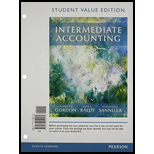
Conceptual Framework. Noeleen Auto Mall, Ltd. recently completed an initial public offering (IPO) for $23,003,000 by listing its common shares on the New York Stock Exchange. Prior to its IPO, Noeleen was a privately held family business. As a public company, Noeleen faces increased reporting requirements, particularly those sanctioned by the Securities and Exchange Commission (SEC). Noeleen’s Controller, Donald Lierni, was surprised to learn that a Form 10-Q was required to satisfy the company’s first-quarter filing requirements with the SEC. Lierni lacked sufficient time to develop the “actual” numbers needed to prepare the report, meaning that he needed to make significant estimates before the 10-Q filing due date. In addition, Noeleen now must satisfy a new group of financial statement users with additional information needs. Noeleen expended resources to meet the new reporting requirements and assess what information and disclosures to include/exclude from the financial reports. Lierni also learned that privately held companies are not subject to U.S. GAAP requirements like a publicly traded entity. That is, the company now must follow additional U S. GAAP standards and is required to change several of its accounting methods. When considering his options, Lierni decides to take a “safe” approach and report the lowest income possible by adopting income-reducing standards. Here, the Controller proposes taking excessive write-downs for obsolete inventory and potentially impaired assets. He also decides to expense the cost of a significant investment in office equipment.
Finally Noeleen created a separate legal entity to handle its auto financing, Benedict Arnold Credit Company, during the same year it went public. The separate entity is not consolidated with the primary financial statements. Lierni decides to keep this entity off of the
Based on the information provided, list and explain the application of the relevant components of the conceptual framework of accounting. Identify seven issues and use the following table to present your solution.
| Issue | Conceptual Framework |
| 1.__________ | 1.__________ |
| 2. __________ | 2. __________ |
| 3. __________ | 3. __________ |
| 4. __________ | 4. __________ |
| 5. __________ | 5. __________ |
| 6. __________ | 6. __________ |
| 7. __________ | 7. __________ |
Want to see the full answer?
Check out a sample textbook solution
Chapter 2 Solutions
Intermediate Accounting - Myaccountinglab - Pearson Etext Access Card Student Value Edition
- Can you solve this general accounting problem with appropriate steps and explanations?arrow_forwardPlease explain the solution to this general accounting problem with accurate explanations.arrow_forwardCan you solve this general accounting question with the appropriate accounting analysis techniques?arrow_forward
- Please provide the answer to this general accounting question with proper steps.arrow_forwardCan you help me solve this general accounting question using valid accounting techniques?arrow_forwardI am trying to find the accurate solution to this general accounting problem with the correct explanation.arrow_forward
- Business Its Legal Ethical & Global EnvironmentAccountingISBN:9781305224414Author:JENNINGSPublisher:Cengage
 Auditing: A Risk Based-Approach (MindTap Course L...AccountingISBN:9781337619455Author:Karla M Johnstone, Audrey A. Gramling, Larry E. RittenbergPublisher:Cengage Learning
Auditing: A Risk Based-Approach (MindTap Course L...AccountingISBN:9781337619455Author:Karla M Johnstone, Audrey A. Gramling, Larry E. RittenbergPublisher:Cengage Learning

